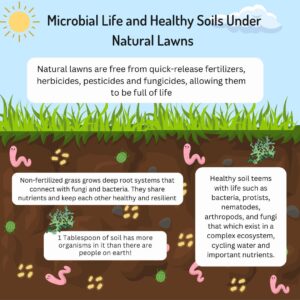Tuesday, July 18, 2023
Excessive greenhouse gasses in the atmosphere are warming our planet, damaging ecosystems, and increasing extreme weather events with devastating costs. There are currently 422 ppm of CO2 in the atmosphere, but scientists have set the critical goal of reducing those levels to 350 ppm. The question is, where can that carbon go? Soil is the solution.

Soil has a remarkable capacity for long-term carbon storage. Globally the world’s soils already hold over 2800 billion tons of carbon. The world’s above-ground biomass (all plants and trees) contains about 564 billion tons of carbon, but when those plants die some of their carbon is released. For example, trees can store carbon for hundreds of years, which is considered short-term storage.
The key is that when plants photosynthesize, they take in CO2 from the atmosphere and then transform it into liquid carbohydrates that they push from their roots. Once that carbon is in the soil it goes through a chemical process and becomes humus, which stores carbon for thousands of years (long-term storage). That’s where your backyard lawn can play an important role in carbon sequestration. Grasses put half of the CO2 they use during photosynthesis into the ground as root exudate. Naturally managed lawns can help us get closer to the goal of 350 ppm of carbon dioxide and build healthy soil.

A natural lawn means a lawn without fertilizer, pesticides, or herbicides. Fertilizing your lawn teaches the grass to find all its nutrients at the soil’s surface, which creates shallow root systems that are worse at sequestering carbon and make the grass more vulnerable to drought. Pesticides and herbicides kill the soil life and microbial diversity and disrupt important nutrient cycling in the soil. Natural lawn practices allow the grass to build more soil, which can hold more carbon and also acts as a sponge.

Soil is a diverse ecosystem of microscopic organisms which work together to break down materials, cycle nutrients, store carbon and water, and support plants in their growth. Healthy soil teems with life made up of bacteria, protists, nematodes, arthropods, and fungi. The relationship between plants and fungi is particularly important for plants’ ability to survive. Tiny strands of mycorrhizal fungi stretch from the roots of plants deep into soil, forming a complex network. Fungi communicate with plants and provide nutrients and water that they would not otherwise be able to access. Plants, in return, provide fungi with sugars that give plants energy to grow. Without microbial life, the soil is not able to cycle nutrients or hold water and it becomes degraded, releasing CO2 and other gasses into the atmosphere.

Here are some tips on how to “green” your lawn and help sequester carbon:

The Ocean River Institute provides opportunities to make a difference and go the distance for savvy stewardship of a greener and bluer planet Earth. www.oceanriver.org